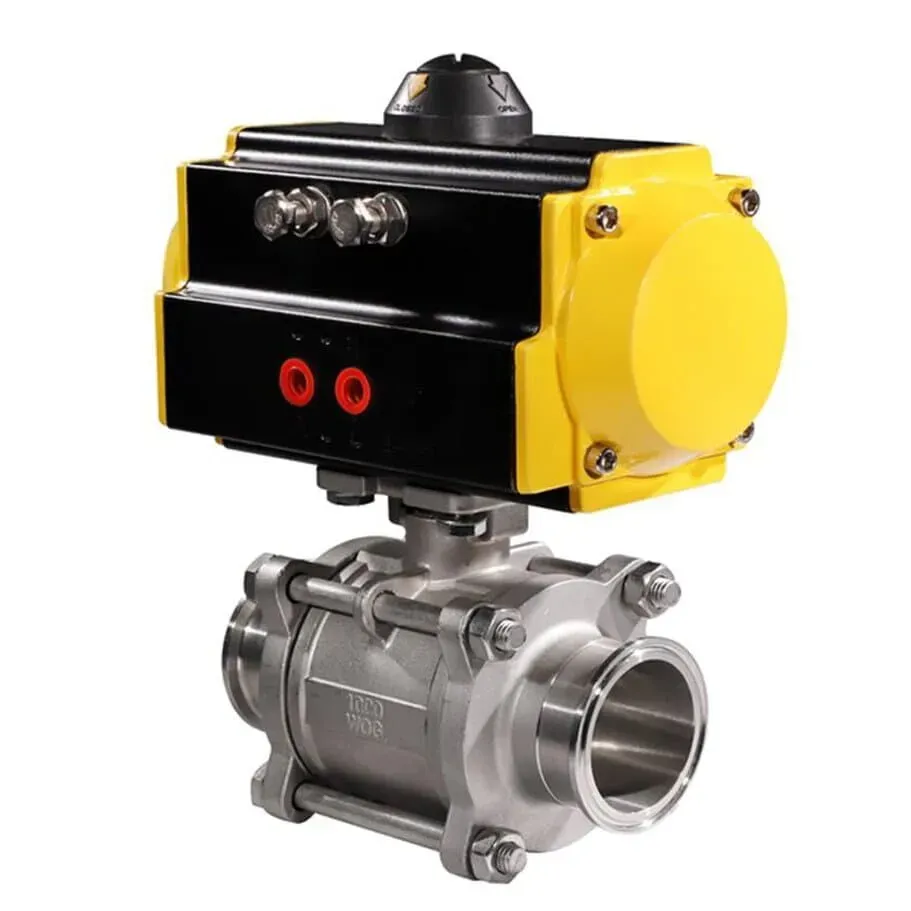In industrial automation, selecting the right pneumatic actuator is essential for achieving optimal performance and long-term reliability—especially in environments where corrosion poses a persistent threat. Pneumatic actuators are integral to valve automation systems, providing precise control and consistent operation in a wide array of industries, including chemical processing, water treatment, marine engineering, and food manufacturing.
When it comes to corrosive environments, choosing the correct actuator involves more than just selecting the right type. The material composition of the actuator body, internal components, and actuator type must align with the application's specific conditions—pressure, temperature, and chemical exposure. This guide explores the best material options and pneumatic actuator designs for corrosion resistance, helping engineers and operators make informed decisions.

304 stainless steel is one of the most commonly used materials due to its good mechanical properties and moderate corrosion resistance. It is ideal for mildly corrosive environments, such as in the food and beverage sector where hygiene and resistance to weak acids and alkalis are required.
For more aggressive conditions—such as chemical plants, coastal facilities, or marine vessels—316L stainless steel is preferred. The addition of molybdenum in this alloy enhances its resistance to pitting and crevice corrosion, offering a robust solution against seawater and chloride-based media. In marine engineering, for example, 316L pneumatic actuator valve bodies ensure stable operation even with continuous exposure to saline environments.
Known for its outstanding performance in harsh chemical environments, Hastelloy is ideal for processing media that involve strongly oxidizing or reducing acids, as well as chlorine-laden compounds. Its ability to withstand both high pressure and high temperatures makes it a top choice in the petrochemical and pharmaceutical sectors.
This nickel-copper alloy offers excellent resistance to hydrofluoric acid, brine, and seawater, making it highly suitable for applications in marine and offshore platforms. Monel's durability under fluctuating chemical conditions ensures extended service life in valve automation systems where other metals might fail.
In less corrosive settings, plastic actuator valve bodies provide lightweight and economical alternatives. Polypropylene, in particular, is a good fit for applications involving dilute acids and alkalis. It is often used in chemical dosing systems and laboratory environments.
Widely used in chemical wastewater treatment, PVC offers excellent chemical resistance, especially against acidic and alkaline solutions. PVC pneumatic actuator valve bodies are also non-conductive and easy to install, making them suitable for low-pressure, low-temperature applications.
The actuator's mechanical function is just as important as its material construction. Pneumatic actuators come in various types, each designed for specific motion requirements—linear, rotary, or gripping.
Linear actuators transform compressed air energy into straight-line motion. They are commonly used for operating gate valves, globe valves, and other components that require direct axial movement.
Single-Acting Linear Actuators: Feature a return spring that automatically resets the actuator when air pressure is removed. These are ideal for safety-critical systems that must fail to a default position during power loss.
Double-Acting Linear Actuators: Use air pressure for both extension and retraction. These offer greater force and control, suitable for high-cycle operations in industries like packaging, oil & gas, and pharmaceuticals.
Typical Applications:
Valve automation in wastewater treatment
Material handling systems
Cylinder-based control mechanisms in cleanroom operations
Rotary actuators convert air pressure into rotational motion. They come in two primary designs: rack-and-pinion and vane-style.
Rack-and-Pinion Rotary Actuators: These deliver high torque and precise control over fixed angles, typically 90°, 180°, or 270°. They are highly reliable in harsh conditions and often used with butterfly and ball valves.
Vane-Type Rotary Actuators: Provide smoother motion and are more compact, but typically deliver lower torque compared to rack-and-pinion designs.
Typical Applications:
Quarter-turn valve automation
Indexing systems in packaging and assembly lines
Flue gas control in power plants
Grippers are specialized actuators used for holding and manipulating objects. They operate using compressed air to open and close fingers or jaws, and come in several configurations:
Parallel Grippers: Move fingers in a straight, parallel path. Best for uniform shapes.
Angular Grippers: Use a pivoting motion, ideal for tight spaces.
Three-Point Grippers: Provide three contact points for stable gripping, suitable for irregular objects.
Typical Applications:
Pick-and-place operations in automated manufacturing
Robotic arms in electronics and automotive industries
Medical packaging and cleanroom handling
When selecting a corrosion-resistant pneumatic actuator, the following factors should guide your decision:
Ensure the actuator body and internal components are chemically compatible with the process media. For example, acids containing chlorides demand alloys like Hastelloy or 316L stainless steel, whereas mild alkalis might only require PP or PVC.
Materials and actuator types must withstand the process's operating conditions. High-pressure, high-temperature applications require robust construction materials and double-acting mechanisms.
Outdoor installations, offshore platforms, or areas with high humidity and salinity necessitate materials resistant to atmospheric corrosion, such as Monel or 316L.
Choose the actuator type—linear, rotary, or gripper—based on the motion requirement of the application. This also determines the actuator’s configuration, control accessories, and required maintenance.
In corrosive settings, selecting low-maintenance actuators made from corrosion-resistant materials can reduce downtime and extend service life.
Industries such as food and pharmaceuticals may require actuators that comply with standards like FDA, ATEX, or ISO. Stainless steel and plastics like PTFE are commonly used in these regulated environments.
In corrosive industrial environments, pneumatic actuators must be carefully selected not only for performance but also for material resilience. Whether operating in marine, chemical, pharmaceutical, or wastewater treatment systems, choosing the right combination of actuator type and corrosion-resistant materials can dramatically increase operational reliability and service life.
From 316L stainless steel for marine systems to Monel for acid-resistant setups, the right materials make all the difference. Pairing these with the appropriate actuator design—linear for straight-line valve motion, rotary for angle turns, or grippers for object manipulation—ensures seamless and safe automation across any industrial application.
By understanding the properties of available materials and actuator mechanisms, engineers can confidently specify pneumatic actuators that meet both environmental challenges and operational needs.
